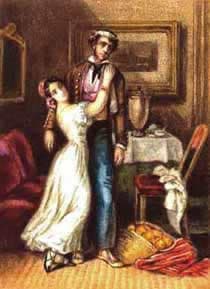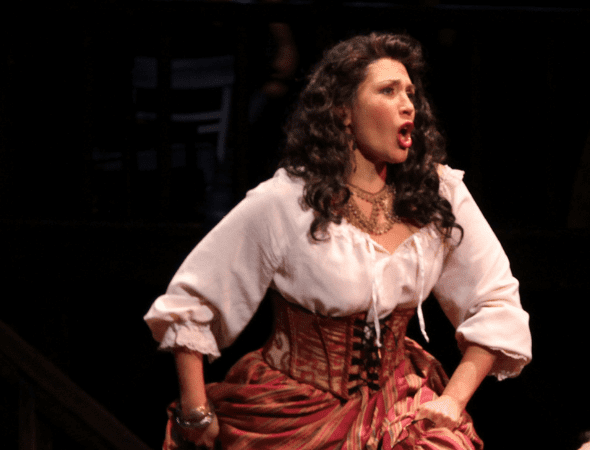Composer Georges Bizet (1837-1875) and his Carmen
Bizet composed Carmen in 1875, when he was 37 and had a decent reputation as a composer, but was not classed as one of the most important in France; in fact, considering the high expectations of him in musical circles, his career so far had been something of a disappointment. He was one of the youngest pupils ever admitted to the famously rigorous Paris Conservatoire and, as one critic wrote, quickly learned everything the professors could teach. He also won most of the prizes available to be won, including the fabled Prix de Rome — the Conservatoire’s highest award for composition — at age 19. And though his early operas did not hint at the boldness of inspiration in Carmen, they did reveal the freshness of his melodic inspiration and his gift for evoking the vividly detailed, richly textured scenes in music. Eugène Cormon and Michel Carré, the librettists for his opera The Pearl Fishers (12 years earlier than Carmen), reportedly said “if we had known Bizet would write such beautiful music, we would have written a better libretto.” And just three years before Carmen, when Bizet composed the incidental music for the play L’Arlésienne, playwright Alphonse Daudet supposedly described his own play as “a glittering flop with the loveliest music in the world.” Tragically, Carmen would prove to be Bizet’s final masterpiece.
In Mérimée’s novella Carmen we learn more about Carmen’s doomed lover Don José than we see in the opera. He is depicted as a rather ordinary man with a troubled past who undergoes a rather extraordinary disintegration. This kind of story, representing female sexuality as a corrupting influence and southern peoples as dangerous, was common in pulp novels of Mérimée’s day; he wrote at a time when Gypsies were seen by most Europeans as a mysterious, filthy, dangerous people. But it’s possible that his view of this subject was more complex, since he had visited Spain and had a relationship with a Gypsy girl. When he returned home and wrote about his experiences, he described the girl as “savage and unsociable,” but his attraction to her was clear, and she may well have been the model for his Carmen.
Another source contemporaneous with Bizet was George Henry Borrow, a British writer and translator who explored Madrid, Granada, Seville and Cordoba. In The Gypsies of Spain, Borrow called them the Zincali, Gitános, or Bohemians, “wild and sybilline,” frequently beautiful but never vulgar. And, he added, they despised Christians. His down-to-earth characterization of the Gypsy woman is sympathetic in its fascination, if also patronizing: The Gitána is “addicted to and famous for fortune-telling,” he said; she is the one woman in the world who “deserves the title of sorceress.… Mention to me a point of deviltry with which that woman is not acquainted, for she is a prophetess…a procuress…and a singer of obscene songs.…Tenacious of the little she possesses, she is a cutpurse and a shoplifter whenever the opportunity shall offer.”

Original by Prosper Mérimée., Public domain, via Wikimedia Commons
In 1875, the year Carmen was first produced, such characters were simply not seen on the operatic stage. Queen Victoria was still on the throne, and the moralists of her generation were in full cry. Nor were they alone in fighting a decency crusade; the Empress Eugénie had left a mark on Bizet’s France by imposing her rigid, Spanish-Catholic code on it. If such shocking material was to be introduced in opera, the Opéra-Comique was perhaps the last venue where it might have been expected; this venue, after all, was where respectable bourgeoisie could expect reliably inoffensive entertainment. But change was in the air, and it came with Realism. It reached French art and literature through painters including Degas and Courbet, who depicted common laborers and scenes of everyday life, and writers including Balzac and Flaubert, who populated their novels with startlingly real people.
Opera had already taken important steps toward Realism in the 1850s with Giuseppe Verdi’s La traviata and Un ballo in maschera. Many of that era’s elegant operagoers thought of the elegant courtesan Violetta Valéry as a virtual prostitute and were shocked by Verdi’s frank, sympathetic depiction of her. In the last act of Traviata he thrust Realism on the audience by showing Violetta on her deathbed suffering the ravages of tuberculosis, a ghastly killer. As for Un ballo, the scene of the king’s assassination was so realistic (and politically unflattering) that when Verdi was about to mount the first production, the Neapolitan censors refused to let him produce the opera as he had written it. They forced him to find another setting for it, and so the action was somewhat incongruously transferred to colonial Boston. For years after the opera’s premiere, censors still insisted on changing the opera’s title, setting, plot and characters. Though these were signs of a trend toward Realism two decades before Carmen arrived on the scene, Bizet’s opera forced it to a level for which the public was not yet prepared.

Leann Sandel-Pantaleo performing title role in Utah Opera’s 2010 production of Carmen
Controversy erupted over Carmen even before the first rehearsals began. By the time of its premiere at the Opéra-Comique in Paris on March 3, 1875, arguments over the scandalous plot were raging in cafés and in the theater itself. Bizet was also criticized for producing it at the Opéra-Comique, which was considered a venue where middle-class families could count on wholesome entertainment…”A place where a man can take his wife and daughters.” The first performance of the opera brought the critics out in force, with some attacking the composer for imitating Wagner’s leitmotif technique. Others claimed that he, like Verdi and Wagner, was ruining singers’ voices by drowning them out with “dissonant” and “heavy” orchestral sound. But there were dissenters, including the writer Blaze de Bury, who praised Bizet and said he had “no doubt” about the composer’s future. Another critic praised the “huge talent in this musical score.”
The supposedly calamitous first-season failure of Carmen has entered the canon of music lore. Are the stories true? Probably not. The opera was performed 37 times at the Comique during its first run (though often to a half-empty house), and successfully revived during the next season. A real fiasco would have closed after just one performance, as Verdi’s Un giorno di regno and Puccini’s Madama Butterfly did. Or, in the worst possible scenario, the audience would have forced the curtain down in the middle of the show and made the impresario refund the ticket money, as sometimes happened in Paris.
When Bizet died, three months after the premiere of his wildly revolutionary opera, he knew it would survive. But could he have dreamed that it would become one of the most popular and influential works in the history of the theater, setting the parameters for a new structure and style in opera? Public and critical enthusiasm for Carmen only grows with time. Perhaps the first “daughter” of Carmen was Jules Massenet’s Manon (1884), whose amoral heroine seduces a young seminarian just as he is about to become a priest. From there, the raw brutality of Italian verismo was already within reach. Today, Carmen‘s irresistibly passionate music and stark drama have transcended style and geography, and are embraced throughout the world.





